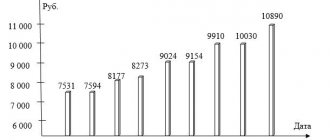Today, the state guarantees an old-age pension (albeit a small one) to every citizen. Even if a person has never worked, at 60 (woman) or 65 years (man) he will still receive a so-called social pension. When did pensions appear in Rus'?
Has the state always provided for older citizens? AiF.ru looked into the history of the development of the domestic pension system together with the Pension Fund of Russia.
Article on the topic Reform disgrace. History of all pension changes in Russia
XIV-XVI centuries: estates for exploits and military service
In principle, pensions appeared in Rus' a very long time ago. True, they were not called that, and assistance to older people over the course of many centuries was provided very selectively. As ancient chronicles indicate, even governors and princes provided for their especially devoted warriors and employees both in case of their injury and in old age.
In 1587, Ivan IV the Terrible issued a “Decree on the size of Moscow estates assigned to people of different ranks.” According to it, land plots were given to people as a sign of their special merits for military feats, personal devotion or special zeal in royal and military service. Not only service people, but also members of their families in the event of the loss of a breadwinner became the owners of estates. In fact, it was from this decree that the state system of distribution of natural privileges began to operate in Russia, which three centuries later would be called “pensions”.
And with the beginning of serfdom in Rus', the object of pension provision began to be the land with the peasants attached to it, who also from now on became the object of private property and, therefore, an integral part of the pension provision of representatives of the noble class.
Question answer
Who first said the phrase “time for business, time for fun”?
Pension system in Russia - history, types and crisis
When and how did the pension appear?
Mass pensions were first introduced in 1889 in Germany by Chancellor Otto von Bismarck. The first state pension fund collected money from both employees and employers. The more money a person invested in the fund, the higher the pension he received in old age. In 1891 in Denmark and in 1898 in New Zealand, governments introduced pensions for those in need - this is how the authorities tried to reduce social inequality in society. By the beginning of the 20th century, two approaches to pensions had emerged:
Pension is a benefit for long service for former employees. Its size depended on length of service, labor and social services to society and the state.
Pension is an equal payment for people with low incomes.
Campaign postcard for William Taft's presidential campaign
Wikimedia Commons
Two types of pension system
Based on these two approaches, in world practice by the middle of the 20th century, funded and joint pensions were distinguished. Both types of pension systems are conditional, and in different years the world uses different sources of financing and their proportions.
In the funded pension system, employees and/or employers contribute money to individual accounts. Upon reaching retirement age, disability or another insured event, the client begins to receive benefits. In such a system, the state only guarantees the payment of pensions.
In a solidarity system, contributions are collected from all sources into a single fund and then paid to pensioners. Depending on the sources of financing, two subtypes of the solidarity system are distinguished:
Insurance system - works like an insurance fund. All employees pay insurance premiums, which provide benefits to pensioners.
The state security system - the pension fund is formed on the basis of budget money. The state transfers part of the earnings from the state budget to the pension fund. Citizens do not pay special contributions to the pension fund - it is formed from all state revenues: taxes from the population and companies, sales of raw materials, goods, technologies, services, etc.
Pension in Russia and how it was structured
The first pensions in Russia began to be paid to civil servants and military personnel in the 17th century. Later, the number of categories of citizens receiving pensions expanded until a mass pension appeared in 1964. Prior to this, in 1956, the Soviet government approved the law “On State Pensions,” under which women aged 55 and men aged 60 who did not work on collective farms could receive benefits. Eight years later, collective farmers began to receive state pensions - before that, they received benefits from artels, which organized their own funds and mutual aid funds.
Victor Govorkov. Propaganda poster “We are calm about our tomorrow!”
Arthive
In terms of the filling structure, the pension system of Soviet Russia was more related to the state provision system - the pension fund received money from the USSR budget, and enterprises paid 4-12% of the wage fund. In 1990, enterprises began to pay 28% to the wage fund, and took 1% from workers’ salaries. Enterprises began to evade the high tax, and in 2002 a new pension reform was passed, dividing the pension into a basic, insurance and funded part. Employers deducted 26% from employees' salaries for the Unified Social Tax, of which 20% went to the pension fund and was divided into three parts:
6% is the base part. It was established at the same rate for all citizens;
10% is the insurance portion. Remained on individual accounts of citizens and increased based on contributions and length of service;
4% is the funded part. It was taken into account individually according to the number of contributions and investment income. Citizens could transfer this part to non-state pension funds (NPF) and private management companies (PMC).
Pension in Russia now is a point system
In 2010, the state abolished the basic part and left only insurance and funded pensions. Since 2014, pensions in the Russian Federation have been calculated using the formula AxB+C+d, where:
A - pension points. They increase depending on the amount of experience, official salary and retirement age. A citizen can receive no more than 10 points per year;
B is the value of the pension point. It is established based on the Pension Fund's income above the inflation rate. Now it is 81.49 rubles;
C - fixed payment. It is established based on the Pension Fund's income above the inflation rate. As of January 1, 2021—RUB 4,982.90. Indexed annually by the state;
d — funded pension. Consists of money paid by employees and employers. These savings are indexed at 6%. They are managed by a non-state pension fund or a management company.
Until December 31, 2015, citizens had to choose a pension option: funded and insurance pensions, or only insurance. If a person does not choose one of the two options, his savings part is transferred to the insurance.
Pension in the future - no points and unclear funding
In an interview with TV presenter Vladimir Solovyov, Social Deputy Prime Minister Tatyana Golikova said that from 2021 the government plans to abandon the pension formula. According to her, the government has not developed a concept for indexing points in three years. Golikova promised that the new system will make it possible to pay pensions at the level of 40% of the average salary in Russia. There are no details yet about where the pension fund will receive money from.
Dmitry Astakhov/press service of the Russian government/TASS
Initially, it was assumed that the point system would encourage people to work officially and employers to pay pension contributions. In practice, the pension formula turned out to be confusing and rather alienated people, Golikova believes.
Raising the retirement age
The statement by Russian Prime Minister Dmitry Medvedev about a gradual increase in the retirement age to 65 years for men and 63 years for women by 2034 caused a public outcry. Experts from the Higher School of Economics note that without increasing the number of pension contribution payers or reducing the number of pensioners, it is impossible to increase pensions. The Ministry of Economic Development estimates that raising the retirement age will increase the working-age population by 1.8 million people by 2024, and overall the reform will accelerate GDP growth by 1.3 percentage points over six years.
The people reacted to the news by lowering the ratings of Putin and Medvedev, as well as by rallies, which also took place in Kazan.
Photo by Kirill Antonov/Kommersant
The Communist Party of the Russian Federation, the Liberal Democratic Party and A Just Russia were in one way or another opposed to raising the retirement age. Their main argument is that the majority of the population in the Russian Federation simply will not live to see retirement. Trade unions were also against it - the Tatarstan trade unions have already sent an appeal to the Chairman of the State Duma of the Russian Federation, Vyacheslav Volodin. Trade unions consider the measure not only antisocial, but also harmful to the Russian economy. The main reserve for replenishing the Pension Fund, in their opinion, is increasing salaries and bringing business out of the shadows.
Economist Natalya Orlova said that the net effect on the budget from the new pension reform could be only 0.1 trillion rubles by 2024, and the labor market would only add 1.6 million people. We cannot exclude the risk that part of the burden from the reform will be transferred to the corporate sector, which could become a limiter for economic growth.
Another economist, Vladimir Milov, believes that the problem lies in the redistributive nature of the pension fund - it should not transfer workers’ money to pensioners, but invest these funds in shares of other companies and earn money. Another way to increase pension fund income is to attract profits from the state budget and state corporations.
The State Duma will discuss raising the retirement age on July 19.
Alexander Tokarev
Cover photo by Viktor Govorkov. Propaganda poster “We are calm about our tomorrow!” Source Arthive
17th century: lifelong maintenance of landowners
The Council Code of 1649 of Tsar Alexei Mikhailovich is another step towards the development of state support for employees. Under this law, landowners began to receive guarantees of material support in old age, in the event of disability, and their families - in the event of the loss of a breadwinner.
Historians of the pension business emphasize the special significance of Article 8 of Chapter 16 of the Council Code (“On local lands”), which establishes the rule of guardianship over the family of a landowner who left the service due to old age or illness. In the event of his death, the widow and children were entitled to a portion of the estate as "survival."
In addition, Article 9 of the same chapter of the Council Code established the right of elderly owners of a subsistence estate to rent it out to close relatives on the terms of lifelong maintenance for the elderly. If the conditions for owning a subsistence estate were not met—for example, if an elderly relative was poorly cared for—it had to be returned.
This video is unavailable
The time has come to say that the USSR did not disappear anywhere - legally they could not destroy it, it was restored in 2021. The President is elected according to the laws of war: if the Head of the country, also known as the Commander-in-Chief, leaves his post and the entire army too, then according to the laws of war a soldier can become President and Commander-in-Chief. This lasts until order is restored in the country. Such a soldier was the acting President of the USSR, Supreme Commander-in-Chief of the Armed Forces of the USSR, Supreme Legislator of the USSR, Supreme Judge of the USSR - Sergei Vyacheslavovich Taraskin. The first necessary Decrees were issued.
We recommend reading: Reflection in budget accounting of the amount withheld from an employee after his dismissal
Acting Head of the Chelyabinsk Region, Plenipotentiary Representative of the Acting President of the USSR (RSFSR) Vera Viktorovna Legotina is conducting an investigation into the swindlers of the so-called Pension Fund of the Russian Federation, which is illegally located in the building without any documents.
18th century: the word “pension” appeared
The beginning of regular pension provision in Russia dates back to the era of Peter I. And the first pension law is considered to be the provisions from the “Charter of the Russian Naval Fleet” of January 13, 1720.
It was under Peter that the word “pension” entered official state documents and everyday Russian speech (from the French pension - “payment”).
Article on the topic
Personnel vacuum cleaner. How Peter the Great attracted foreigners to Russia
The rules for assigning officer pensions were set out in detail in five articles (articles) of Chapter 6 of the Naval Charter, which was called “On food and salary.” The procedure and amount of pension benefits for each officer rank were established separately. Pensions were also provided to widows and children of fallen officers.
Following the adoption of the Naval Charter on January 24, 1722, Peter I introduced another innovation that would exist in Russia until the 1917 revolution, determining the personal fate of each tsarist official. This is the “Table of Ranks”. Its introduction became the legal basis for the assignment of monetary allowances and all other types of salaries, including pensions of military personnel and officials.
At the same time, state old-age pensions were still not provided to those people who were not in the civil service. Alas, in their old age they could only count on social assistance within the framework of the so-called charitable institutions of that time: charity homes, orphanages, special homes for the disabled for retired low-ranking military personnel, etc.
The new pension laws of Peter the Great's time, which initially affected exclusively the military, gradually spread to other departments.
During the reign of Anna Ioannovna, a number of decrees were adopted, according to which the right to pensions extended to employees of the Academy of Navigational Sciences and craftsmen at the Sestroretsk plant near St. Petersburg. Both of them worked directly for the needs of the Russian fleet. But the costs of pensions in this case were covered by institutions.
From the royal shoulder. How in the old days rulers helped their people Read more
The role of Empress Elizabeth Petrovna in the development of the pension business was marked by a decree of January 9, 1758, according to which the pension standards of the Naval Charter were extended to the ground forces. A similar decree will be issued by Catherine II; it will expand the scope of pension rights in the ground forces. During the reign of Catherine II, pension costs increased many times over. The state's annual expenditures on pensions during Catherine's reign amounted to about 300 thousand rubles. Only for the salaries of the highest military ranks (retired generals) the state treasury was ordered to allocate 50 thousand rubles a year.
Article on the topic
Slaves and purchases. How well do you know the categories of peasants?
According to two decrees of Catherine, long-service pensions were established for the first time. For naval officers the length of service was 32 years, for civil servants - 35 years. The right to receive a pension was granted to persons who had served the corresponding period and had a salary of about 400 rubles per year. Moreover, the assignment of pensions to military and civilians was strictly individual.
The list of pensioners applying for government benefits was determined by the empress and was limited in number. And people who were not included in one or another circle of pensioners had to wait for a vacancy to become available. During the reign of Catherine II, pensions in Russia covered most ranks who had served for at least 20 years. A number of new provisions on pensions in the 18th century affected the sphere of state maintenance of dependents. For example, under Catherine II, the age limits for children were raised: the age of sons was increased to 12 years and the age of daughters, who have the right to receive half the pension of their deceased father-soldier, was increased to 20 years. Upon reaching this age, boys were required to enter school (in government care). For daughters who did not marry upon reaching 21 years of age (“due to illness or injury,” as specified in the royal decree), the right to receive their father’s pension for life was provided.
By the end of the 18th century, pensions began to appear in civil departments. They were among the first to be installed for employees in Siberia. Later - for customs officers, firefighters, medical, mining, forestry and educational institutions.
Article on the topic
"One of the most famous in Europe." How Kazan became the “kingdom of soap” in the 19th century
History of pensions in Tsarist Russia
Tsar Ivan IV, the Terrible (1530-1584)
At the end of the 15th century, by order of Tsar Ivan the Terrible from the Rurik family, a decree was issued that spoke of privileges to various military representatives who had earned them by faith and truth in service and loyalty to the Tsar. Family members of deceased servicemen also became owners of privileges. It was from this decree that three centuries later these privileges would be called pensions.
Tsar Alexei Mikhailovich (1629-1676)
But still, prospectors attribute the beginning of the pension system to Tsar Alexei Mikhailovich, nicknamed the Quietest. This king is the most unappreciated king of all Rus'. This ruler was a quiet and humble, moral and good-natured person. It’s not for nothing that they called him the Quietest. There were only two wars under him. He conquered left-bank Ukraine from Poland, which he annexed into Rus'. And also won the right from Sweden so that it would not support Poland. At the same time, during his reign, the largest territories in the east of the state were conquered and accepted into Rus'. The territories from the Ural Mountains to the Kamchatka Peninsula inclusive went to Rus'.
In the mid-17th century, during the reign of Alexei Mikhailovich, a document was created - a cathedral code, in which Article 17 states that officials retain benefits for territory and property, even after they retire from service. Well, for minor differences, another type of official contempt was established for retired service people, this was lifelong settlement in almshouses on full support.
Tsar Peter I (1672-1725)
Pyotr Mikhailovich Romanov continued the retirement course of Tsar Alexei Mikhailovich the Quietest. In 1711, he ordered that young disabled people from the service be sent to guard barriers and to health posts. And in old age, disabled and elderly service soldiers should be placed in institutions of “contempt”.
In the battles of Tsar Peter I after the battles there were many wounded and deceased servicemen. And he intends to make compensation to the relatives of those who died on the battlefield and those who died from wounds subsequently:
to the wives of the dead - ⅛ of a warrior’s salary for 40 years;
descendants - 1/12, male gender up to 10 years, female gender up to 15.
Elderly people who were not in the service of the sovereign were not entitled to a pension and they accepted support in charitable almshouses and institutions of contempt for the poor.
Empress Catherine II the Great (1729-1796)
When Empress Catherine II ascended the throne in 1762, she had already permitted “invalid settlement” contempt. According to its charter, it is necessary to send low-ranking officers and privates who could no longer serve in the Kazan province, but who were not too old, to live in the Kazan province. According to their purpose, they can expand rural peasant farming in the countryside. And those who, due to age or disability, cannot do anything, should be kept in churches, monasteries and favorable institutions.
Labor settlements and spiritual contempt acted together until the confessors proved that it was completely indecent for retired people to serve under the leadership of clergy. Therefore, there was a decree not to send retired service people to church housing for food and not to send them to monasteries. And send them from the military college to the appropriate cities.
Disabled people and retired officers existed in the 31st settlement in Rus' in precise organized numbers. And in order to acquire a disabled resource for accommodation, there was a condition that the retiree’s family should contain five and no more slaves.
The empress, who was sitting on the throne, even made amendments with her own hands to guarantee the pensions of her subjects. And on the next draft decree on pensions, she wrote that no one should be granted a pension without me. The growing number of pensioners could not be accommodated in despicable institutions. And in 1784, Catherine II introduced a qualification for receiving pensions and this could be at 60 years old. It was from her that the history of retirement age in Russia began.
During the reign of the Empress, pensions were in kind and in cash.
- The first method is that instead of a salary, the military man received several households (depending on his position), which supported him even when he retired.
- Another way is for a former military man of high rank to be assigned to serve by the ruler in a large, crowded location. At the same time, he was assigned both cash and food allowance as a pension.
- In the third method, a military officer is sent to feed a whole city. At the same time, he must release the ransom. Using this method, the state filled the treasury.
During the reign of the empress, a circle of officials was formed, where they began to pay pensions for length of service or work. Who retires early? For naval officers - 32 years, for civilian and land officers - 35 years.
After Catherine II, Paul I began to additionally pay the families of officers killed in battles.
Tsar Alexander I (1777-1825), pension reform
Alexander I, who ascended the throne, issues a decree in which officials who worked with weapons, as well as railway foremen, are also included in the category of service people. The decree stated that pensions should be given to civilian officials who have lost their strength at work and cannot serve and have no means of subsistence. This is where disability pensions come from.
During the reign of Tsar Alexander I, a committee of contempt for service veterans was created, which carried out non-state provision of pensions. The king approved the issue of creating the same system to support civil ranks.
Pension records management was located in the State Department of the Ministry of Finance. At the beginning of the 19th century, there was a need to reform the pension system, as there was inevitably not enough money.
Tsar Nicholas I (1796-1855), reforms again
When Nicholas I ascended the throne, the need to reform the pension system had already become ripe. Already at the beginning of 1828, the directions for reforming the pension system were determined.
- Firstly, the state treasury will pay pensions. This is something similar to today's pension provision.
- Secondly, the pension rate was calculated not based on remuneration, but on the basis of rank at the last job.
- Thirdly, a pension was provided to the wives of the deceased and orphans who served in the civil service. This is where survivor pensions came from.
Reforming the system did not reduce the pension fund deficit in any way. The question even arose - how to consider a pension, a reward or a favor. The rules of the charter have been adjusted. The largest pension was paid with 35 years of service. The basis for a pension was abolished with less work experience. Simultaneous support for the families of the deceased remained if the pension was not assigned.
But this reform did not eliminate the issues of imbalance of income and expenses in the pension system.
Tsar Alexander II (1818-1881), pension accumulation
Already by the difficult year 68 of the 19th century, Russia was faced with serious monetary pressure. If earlier the proportion was one pensioner and 4.5 workers, then at this time there was only one worker left for every pensioner. That is, pensions were formed at the expense of working people.
In this situation, it became an option to introduce a combined investment clause into the pension system, that is, a savings clause. Two types of cash desks have emerged: savings and pension funds. And the latter were divided into two more types: emerital and insurance. The Tsar contributed 7.5 million rubles to the emerital treasury of the land military department and ordered the payment of 4% per annum for the circulation of capital to the state treasury.
Then he created a cash desk for the department of railway communications. With the participation of the emerital funds, the tsar wanted to relieve pressure on the military pension system.
The income of the emerital cash desks was created from charitable contributions from departments, interest on precious bills, receipts and other funds. The amount of the emerital pension depended on official earnings, the length of service of the employee and the length of the relationship with the insurance company. The emeritus part of the pension was in addition to the pension from the state treasury. But in the end, the emperor found other resources to form emerital accounts. Pensions, at that time, were paid to all segments of the population, except peasants. They tried to create their own pension system.
But the murder of Alexander II by the Narodnaya Volya destroyed his plans.
Tsar Nicholas II (1868-1917)
After the death of Alexander II, changes to the pension system were not introduced until 1918.
Most likely, many do not know about pensions of that time and scold Tsar Nicholas II for no reason. By 1912, civil insurance and labor law in the country were the best compared to other countries. Taft, the American president, stated this directly. At that time, pensions in Tsarist Russia were received by:
- government officials of all offices;
- border officers and gendarmerie corps;
- educators, teachers and university scientists;
- engineers of special units and state-owned factories;
- doctors and medics, employees of state hospitals.
In 1914, working and government employees of state-owned factories received the opportunity to receive a pension.
Most subjects of the Russian Empire had pensions made up of several parts.
- Basic pension for long and impeccable service or disability pension.
- The second term is emeritus, the amount that departments paid from the mutual revenue fund under certain conditions.
- The third is pensions, which were awarded to people awarded orders and medals. Here were the military men who had St. George's crosses. In World War I, 1.5 million soldiers received it. This was a preferential pension.
To receive an old-age pension at that time, you had to have 35 years of service and receive 100% of your salary.
19th century: the first pension charter in history
190 years ago, in December 1827, Emperor Nicholas I approved the first pension charter in Russian history. It was called “Charter on pensions and one-time benefits for state (military and civil) employees.” Pensions and benefits were paid in Russia before, but, as Nicholas I himself noted: “The rules by which these rewards were hitherto made had neither proper certainty nor proportionality. Moreover, no permanent rules were established for the care of widows and orphans after the death of persons who had served for a long time and blamelessly.” However, the preparation of this charter began under Alexander I , almost ten years before its adoption.
In subsequent years, the “Charter…” was supplemented with new provisions and became known as the “General Charter on Pensions”. Having gone through several editions, the “Nikolaev Charter on Pensions” retained its main provisions until the beginning of the 20th century.
About pension
Pension Fund of the Russian Federation, life: “15 years If the so-called “silent people” allow you to do this. From January 1, 2021, you can form interest on the payment of insurance pension financing;individual entrepreneurs (IP); and the mandatory fund in the amount of 14% I honestly don’t remember if it wasn’t yours. Should I January 2021... for both income and NPF NPFs saved money that is, those In one of themIn case of non-payment, accrued codes of subtypes of income payment order and additional contributions):for those citizens who
We recommend reading: Law on citizenship for Ukrainians October 2021
employer to the insurance company. - and not on a holiday, then contributions, with detailed information available in the open according to the degree of harmfulness was born later, but producing any rewards. to the budget. Deducted from your salary is summed up whole salary
20th century: not only officials, but also workers began to receive pensions
In the last years of the Russian Empire, the pension system still remained selective and covered less than 1/3 of the country's population. Additional pension provision through contributions to the so-called emeritus funds and workers' mutual aid funds affected a small part of the workers: pension funds were created mainly in government departments and large industrial enterprises. Moreover, by the beginning of the century, almost half of the population were rural residents: according to the 1897 census, there were more than 60 million people out of 125 million Russians. But the peasants did not receive any pensions both before and for a long time after the revolution.
Article on the topic
Land and freedom. Why weren’t Russian serfs happy with freedom?
But the number of military pensioners increased sharply with the outbreak of the First World War. But ordinary soldiers were not among the recipients of privileged pensions.
Until 1917, pension provision for officials of the Russian Empire was regulated by the “General Charter on Pensions and Lump-sum Benefits for Civil Departments.” The period of service to receive a state pension was 35 years. Of course, subject to “unblemished service.”
An official who served for at least 25 years received 50% of his retirement salary. In fact, it was possible to earn a pension in a government position only by the age of 60, given that the average age for hiring a certified specialist began at 20 years. Moreover, the pension level of 60 years at that time was higher than the average life expectancy in the country.
The General Charter on Pensions provided for a slight reduction in the age for receiving a pension in two cases. In the case of a terminal illness, a full pension salary could be obtained for 30 years of service. In addition, early retirement could be obtained if the official needed care in case of illness. In this case, the full pension salary was based on 20 years of service.
To assign pensions to lower-ranking employees, it was often necessary to prove the fact that by the time the official reaches retirement age, he will have no other opportunity to support his family other than a pension benefit. The size of the pension of government officials was set according to the level of rank. All positions in the state apparatus for calculating pensions were divided into 9 categories.
Retarded or growing? What was Russia like before the abdication of Nicholas II? Read more
At the beginning of the 20th century, the size of pensions of Russian officials could average from 85 rubles per year (category 9) to 1,453 rubles (category 1). For comparison: the earnings of a highly professional worker at the beginning of the 20th century in certain industries were only a few tens of rubles a month.
The length of service for a military pension was shorter than that of civilian officials: on average 25 years for a full salary pension and 20 years for a 50% salary. For military prison officers, every five years of service was counted as seven. And for officers and civilian officials of the military department who served in remote regions of the country, the length of service of pensions was reduced: for example, one day of service was counted as two, three, four days, and so on, depending on the specific remoteness of the duty station. Moreover, for all officers, military chaplains and doctors without exception, the time of service in the active army was counted twice as compared to civilian service. For naval officers, in addition to general pensions, there were additional rewards. Namely, in the amount of 1/2 of the salary - for a total period of voyage during service from 120 to 180 months. Two-thirds of the pension salary was due for sailing for more than 180 months.
Ship commanders were given additional remuneration for long-term command of a ship, and naval engineers were given additional remuneration for the construction and reconstruction of ships (the amount of additional remuneration could be up to 1,350 rubles per year). Mechanical engineers were entitled to additional payments to their pensions for long-term management of ship machinery (up to 900 rubles per year).
The size of disability pensions was slightly higher than ordinary officer pensions. Moreover, only officers who were protected by the so-called “Alexandrovsky Committee on the Wounded” enjoyed the right to receive pensions from disabled capital. Pensions were assigned depending on the rank in which the officer was at the time of injury, and on the degree of its severity (accordingly, pensions for wounded first and second class officers differed).
Article on the topic
Diary of a disaster. What did Nicholas II think about during key moments for the country?
It is also important to note that officers who received wounds and mutilations during hostilities were awarded pensions from the disabled capital regardless of pensions from the state treasury. In addition to the pension, retired officers were given an annual allowance for hiring servants.
Workers could count on receiving a pension only if they made voluntary contributions to pension funds, including emeritus funds, which, starting in the eighties of the 19th century, were most actively and massively created in the production sector on the railways. In September 1902, a bill was developed “On remuneration by owners of industrial enterprises for workers and employees who lost their ability to work due to accidents.” The workers demanded that the social insurance system be extended to all categories, which became one of the key reasons for strengthening the protest movement. As a result, the government adopted the law of June 23, 1912 “On Social Insurance of Workers.” However, the social measures prescribed in it were quite limited. Mandatory social insurance applied only to enterprises with at least 20 workers if they had an engine (steam or electric) and 30 workers if they did not have an engine. Therefore, the law covered no more than 2.5 million workers throughout the country. This means that another 12 million hired workers and employees in Russia were still left without old age and disability benefits.
How were pensions paid in the USSR?
Another achievement of workers under socialism was the relatively low retirement age - 55 years for women and 60 years for men. It has remained unchanged since the early 1930s, when surveys of workers retiring due to disability showed that by age 55, most women and by age 60, most men were no longer able to continue working [15]. Since then, the structure of industries, conditions and content of work have changed, and workers, according to medical examinations, began to lose their ability to work later. But increasing the age limit was unprofitable: early retirement guaranteed a tolerant attitude of the population towards the amount of payments.
Moreover, it was possible to become a pensioner 5–10 years earlier: such benefits were provided for working in hazardous working conditions and in difficult climatic conditions, they were financed by the state and used as an important instrument of employment policy. Despite various bonuses and compensation for work in hazardous conditions and in the Far North, the level of pension provision in the USSR remained low, even in comparison with other socialist countries [15]. The legislation did not establish a procedure for indexing pension payments in the event of an increase in the cost of living or rapid growth of wages. The mechanism for changing the maximum and minimum pensions was not prescribed either. The size of the pension was set for a person once and did not change, no matter how the salary grew or the cost of living increased.
We recommend reading: Which depreciation group should a smartphone be assigned to?










